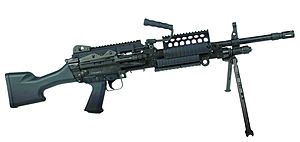The MG4 is a belt-fed 5.56 mm light machine gun designed and developed by the German company Heckler & Koch. The weapon was developed in the late 1990s and was first seen publicly in September 2001. It has been selected to replace the 7.62 mm MG3 general purpose machine gun in the Bundeswehr at the squad support level; it will complement the MG3 in other roles. The MG4 will also be the secondary armament of the new Puma infantry fighting vehicle. Overall, it is designed to be light, provide maximum safety to the user and function reliably under adverse conditions using a wide range of ammunition from different manufacturers, without the need to adjust the gas system. The machine gun was initially known as the MG43 prior to its adoption by the Bundeswehr.
The machine gun is fed from a disintegrating belt and is carried out in two stages from the top left using an enhanced pawl mechanism. Spent cases are ejected downwards, although ejection to the right is an option.
The MG4 has a hammer-forged quick-change barrel that can be safely exchanged when hot without the need for protective gloves; the carrying handle serves as the barrel change grip. To reduce the overall length of the weapon for transport, the butt stock can be folded to the left side of the receiver. With the buttstock folded the MG4 remains fully operable. A field cleaning kit is housed within the stock.
A folding bipod is provided. Supporting interfaces are integrated into the receiver to allow the MG4 to be mounted on the standard American M112A1 tripod for increased accuracy and stability.
In its standard form the MG4 is equipped with closed type iron sights with range settings up to 1,000 m in increments of 100 m. Optical or night sights or laser pointers can be mounted on a length of MIL-STD-1913 Picatinny rail located on the receiver feed tray cover. Models of the Bundeswehr are equipped with telescopic sights with 3x magnification.
Design details
The MG4 is an air-cooled, belt-fed gas-operated weapon with a positively locked rotary bolt and is somewhat similar in concept to the Belgian Minimi light machine gun. Firing in fully automatic mode only. Safety mechanisms on the MG4 includes a manual safety incorporated into fire mode selector toggle; setting the fire selector lever on the "safe" position blocks the trigger mechanically and locks the bolt in the cocked position. When the bolt is not pulled back completely, accidental firing is prevented by an integral, automatic mechanism that prevents the bolt from traveling forward. In addition, the firing pin cannot reach the cartridge primer until the cartridge has been fully chambered.The machine gun is fed from a disintegrating belt and is carried out in two stages from the top left using an enhanced pawl mechanism. Spent cases are ejected downwards, although ejection to the right is an option.
The MG4 has a hammer-forged quick-change barrel that can be safely exchanged when hot without the need for protective gloves; the carrying handle serves as the barrel change grip. To reduce the overall length of the weapon for transport, the butt stock can be folded to the left side of the receiver. With the buttstock folded the MG4 remains fully operable. A field cleaning kit is housed within the stock.
A folding bipod is provided. Supporting interfaces are integrated into the receiver to allow the MG4 to be mounted on the standard American M112A1 tripod for increased accuracy and stability.
In its standard form the MG4 is equipped with closed type iron sights with range settings up to 1,000 m in increments of 100 m. Optical or night sights or laser pointers can be mounted on a length of MIL-STD-1913 Picatinny rail located on the receiver feed tray cover. Models of the Bundeswehr are equipped with telescopic sights with 3x magnification.
| MG4 | |
|---|---|
 The MG4 | |
| Type | Light machine gun |
| Place of origin | |
| Service history | |
| In service | 2005–present |
| Used by | See Users |
| Production history | |
| Designer | Heckler & Koch |
| Designed | 1990s |
| Manufacturer | Heckler & Koch |
| Produced | 2001–present |
| Variants | MG4E, MG4KE |
| Specifications | |
| Weight | 8.15 kg (17.97 lb) (MG4) 7.90 kg (17.4 lb) (MG4E) 7.70 kg (17.0 lb) (MG4KE) |
| Length | 1,030 mm (40.6 in) stock extended / 830 mm (32.7 in) stock folded (MG4, MG4E) 950 mm (37.4 in) stock extended / 750 mm (29.5 in) stock folded (MG4KE) |
| Barrel length | 482 mm (19.0 in) (MG4, MG4E) 402 mm (15.8 in) (MG4KE) |
| Width | 96 mm (3.8 in) |
| Height | 228 mm (9.0 in) |
| | |
| Cartridge | 5.56x45mm NATO |
| Action | Gas-operated, rotating bolt |
| Rate of fire | 775–885 rounds/min |
| Muzzle velocity | 920 m/s (3,018 ft/s) (MG4, MG4E) 880 m/s (2,887.1 ft/s) (MG4KE) |
| Effective range | Approx. 1,000 m (MG4, MG4E) Approx. 900 m (MG4KE) |
| Feed system | Disintegrating link belt |
| Sights | Iron sights; MIL-STD-1913 rail provided for optics, German Army models are equipped with telescopic sights with 3x magnification. |







